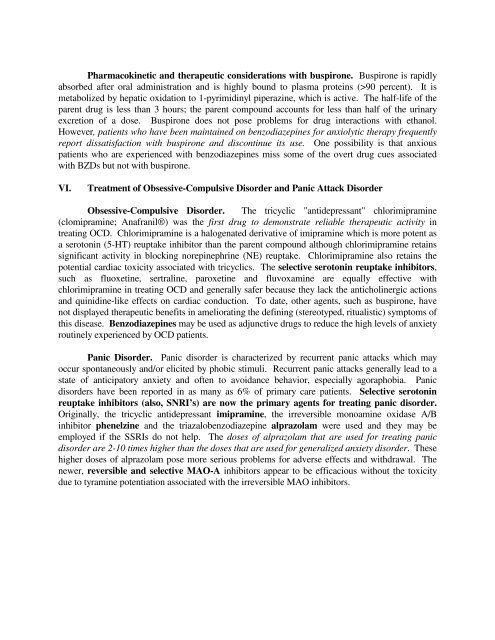Rang & Dale's Pharmacology, 6 Edition, 2007, Chapter 37 Objectives
Rang & Dale's Pharmacology, 6 Edition, 2007, Chapter 37 Objectives
Rang & Dale's Pharmacology, 6 Edition, 2007, Chapter 37 Objectives
You also want an ePaper? Increase the reach of your titles
YUMPU automatically turns print PDFs into web optimized ePapers that Google loves.
Pharmacokinetic and therapeutic considerations with buspirone. Buspirone is rapidlyabsorbed after oral administration and is highly bound to plasma proteins (>90 percent). It ismetabolized by hepatic oxidation to 1-pyrimidinyl piperazine, which is active. The half-life of theparent drug is less than 3 hours; the parent compound accounts for less than half of the urinaryexcretion of a dose. Buspirone does not pose problems for drug interactions with ethanol.However, patients who have been maintained on benzodiazepines for anxiolytic therapy frequentlyreport dissatisfaction with buspirone and discontinue its use. One possibility is that anxiouspatients who are experienced with benzodiazepines miss some of the overt drug cues associatedwith BZDs but not with buspirone.VI.Treatment of Obsessive-Compulsive Disorder and Panic Attack DisorderObsessive-Compulsive Disorder. The tricyclic "antidepressant" chlorimipramine(clomipramine; Anafranil®) was the first drug to demonstrate reliable therapeutic activity intreating OCD. Chlorimipramine is a halogenated derivative of imipramine which is more potent asa serotonin (5-HT) reuptake inhibitor than the parent compound although chlorimipramine retainssignificant activity in blocking norepinephrine (NE) reuptake. Chlorimipramine also retains thepotential cardiac toxicity associated with tricyclics. The selective serotonin reuptake inhibitors,such as fluoxetine, sertraline, paroxetine and fluvoxamine are equally effective withchlorimipramine in treating OCD and generally safer because they lack the anticholinergic actionsand quinidine-like effects on cardiac conduction. To date, other agents, such as buspirone, havenot displayed therapeutic benefits in ameliorating the defining (stereotyped, ritualistic) symptoms ofthis disease. Benzodiazepines may be used as adjunctive drugs to reduce the high levels of anxietyroutinely experienced by OCD patients.Panic Disorder. Panic disorder is characterized by recurrent panic attacks which mayoccur spontaneously and/or elicited by phobic stimuli. Recurrent panic attacks generally lead to astate of anticipatory anxiety and often to avoidance behavior, especially agoraphobia. Panicdisorders have been reported in as many as 6% of primary care patients. Selective serotoninreuptake inhibitors (also, SNRI’s) are now the primary agents for treating panic disorder.Originally, the tricyclic antidepressant imipramine, the irreversible monoamine oxidase A/Binhibitor phenelzine and the triazalobenzodiazepine alprazolam were used and they may beemployed if the SSRIs do not help. The doses of alprazolam that are used for treating panicdisorder are 2-10 times higher than the doses that are used for generalized anxiety disorder. Thesehigher doses of alprazolam pose more serious problems for adverse effects and withdrawal. Thenewer, reversible and selective MAO-A inhibitors appear to be efficacious without the toxicitydue to tyramine potentiation associated with the irreversible MAO inhibitors.
















